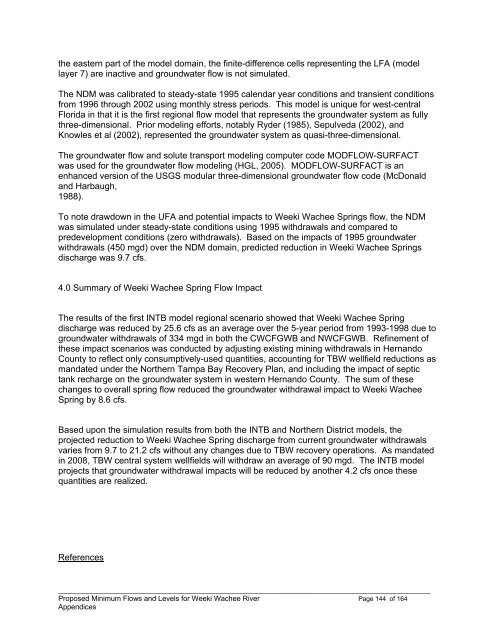Weeki Wachee River System Recommended Minimum Flows and ...
Weeki Wachee River System Recommended Minimum Flows and ...
Weeki Wachee River System Recommended Minimum Flows and ...
You also want an ePaper? Increase the reach of your titles
YUMPU automatically turns print PDFs into web optimized ePapers that Google loves.
the eastern part of the model domain, the finite-difference cells representing the LFA (model<br />
layer 7) are inactive <strong>and</strong> groundwater flow is not simulated.<br />
The NDM was calibrated to steady-state 1995 calendar year conditions <strong>and</strong> transient conditions<br />
from 1996 through 2002 using monthly stress periods. This model is unique for west-central<br />
Florida in that it is the first regional flow model that represents the groundwater system as fully<br />
three-dimensional. Prior modeling efforts, notably Ryder (1985), Sepulveda (2002), <strong>and</strong><br />
Knowles et al (2002), represented the groundwater system as quasi-three-dimensional.<br />
The groundwater flow <strong>and</strong> solute transport modeling computer code MODFLOW-SURFACT<br />
was used for the groundwater flow modeling (HGL, 2005). MODFLOW-SURFACT is an<br />
enhanced version of the USGS modular three-dimensional groundwater flow code (McDonald<br />
<strong>and</strong> Harbaugh,<br />
1988).<br />
To note drawdown in the UFA <strong>and</strong> potential impacts to <strong>Weeki</strong> <strong>Wachee</strong> Springs flow, the NDM<br />
was simulated under steady-state conditions using 1995 withdrawals <strong>and</strong> compared to<br />
predevelopment conditions (zero withdrawals). Based on the impacts of 1995 groundwater<br />
withdrawals (450 mgd) over the NDM domain, predicted reduction in <strong>Weeki</strong> <strong>Wachee</strong> Springs<br />
discharge was 9.7 cfs.<br />
4.0 Summary of <strong>Weeki</strong> <strong>Wachee</strong> Spring Flow Impact<br />
The results of the first INTB model regional scenario showed that <strong>Weeki</strong> <strong>Wachee</strong> Spring<br />
discharge was reduced by 25.6 cfs as an average over the 5-year period from 1993-1998 due to<br />
groundwater withdrawals of 334 mgd in both the CWCFGWB <strong>and</strong> NWCFGWB. Refinement of<br />
these impact scenarios was conducted by adjusting existing mining withdrawals in Hern<strong>and</strong>o<br />
County to reflect only consumptively-used quantities, accounting for TBW wellfield reductions as<br />
m<strong>and</strong>ated under the Northern Tampa Bay Recovery Plan, <strong>and</strong> including the impact of septic<br />
tank recharge on the groundwater system in western Hern<strong>and</strong>o County. The sum of these<br />
changes to overall spring flow reduced the groundwater withdrawal impact to <strong>Weeki</strong> <strong>Wachee</strong><br />
Spring by 8.6 cfs.<br />
Based upon the simulation results from both the INTB <strong>and</strong> Northern District models, the<br />
projected reduction to <strong>Weeki</strong> <strong>Wachee</strong> Spring discharge from current groundwater withdrawals<br />
varies from 9.7 to 21.2 cfs without any changes due to TBW recovery operations. As m<strong>and</strong>ated<br />
in 2008, TBW central system wellfields will withdraw an average of 90 mgd. The INTB model<br />
projects that groundwater withdrawal impacts will be reduced by another 4.2 cfs once these<br />
quantities are realized.<br />
References<br />
____________________________________________________________________________________________<br />
Proposed <strong>Minimum</strong> <strong>Flows</strong> <strong>and</strong> Levels for <strong>Weeki</strong> <strong>Wachee</strong> <strong>River</strong> Page 144 of 164<br />
Appendices
















